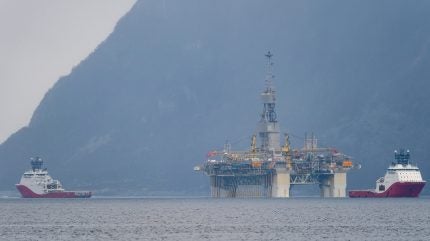
Equinor, alongside its partners, has made an oil and gas discovery at the Gudrun field in the North Sea.
The find was made through wildcat wells 15/3-13 S and 15/3-13 A, marking the 13th and 14th exploration wells in production licence (PL) 025.
The Deepsea Stavanger rig was utilised for the drilling operations.
Preliminary estimates suggest the discovery holds between 0.1 million and 1.2 million standard cubic metres of recoverable oil equivalent within the intra-Draupne Formation.
Additionally, between 0.4 million and 1.3 million standard cubic metres of recoverable oil equivalent have been found in the Hugin Formation.
The licensees, led by Equinor as the operator with a 36% stake, Vår Energi at 25%, OMV (Norge) holding 24% and Repsol Norge with a 15% interest, will evaluate the results in conjunction with the area’s other prospectivity.
How well do you really know your competitors?
Access the most comprehensive Company Profiles on the market, powered by GlobalData. Save hours of research. Gain competitive edge.

Thank you!
Your download email will arrive shortly
Not ready to buy yet? Download a free sample
We are confident about the unique quality of our Company Profiles. However, we want you to make the most beneficial decision for your business, so we offer a free sample that you can download by submitting the below form
By GlobalDataIn a statement, the Norwegian Offshore Directorate said that the primary exploration target for the wells was to confirm the presence of petroleum in the Late Jurassic reservoir rocks of the intra-Draupne Formation and the Middle Jurassic reservoir rocks of the Hugin Formation.
The secondary target aimed to verify a reservoir in the Early Cretaceous rocks of the Rødby Formation, it added.
Well 15/3-13 S identified thin oil-bearing sandstone layers in the intra-Draupne Formation, although the oil/water contact was not encountered.
In contrast, the Hugin Formation revealed 92m of sandstone with poor reservoir properties.
Well 15/3-13 A was more successful, encountering oil within an 85m-thick interval in the intra-Draupne Formation, with 13m of moderate quality intermittent sandstone layers.
Both wells reached their respective measured and vertical depths, with well 15/3-13 S at 4,826m and 4,740m below sea level, and well 15/3-13 A at 4,900m and 4,814m below sea level, terminating in the Middle Jurassic’s Sleipner Formation.
Last week, Equinor and its partners announced a gas and condensate discovery at well 6406/2-L-2 H, situated 260 km south-west of Brønnøysund in the Norwegian Sea.



